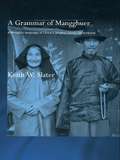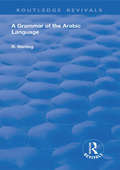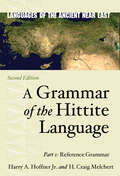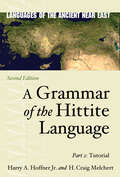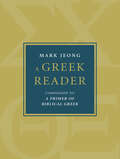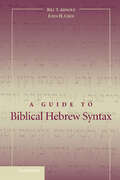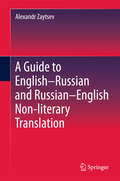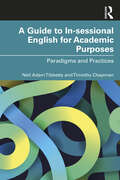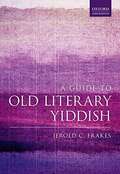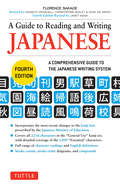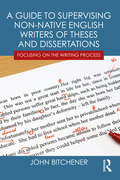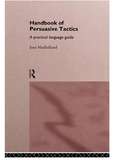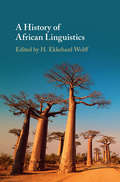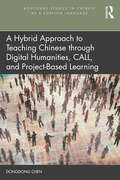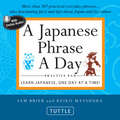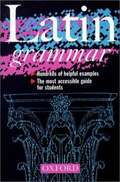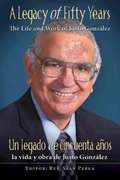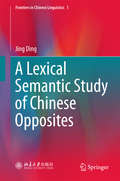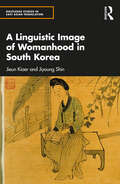- Table View
- List View
A Grammar of Mangghuer: A Mongolic Language of China's Qinghai-Gansu Sprachbund (Routledge Studies in Asian Linguistics)
by Keith W. SlaterThis book is a grammar of Mangghuer, a Mongolic language spoken by approximately 25,000 people in China's northwestern Qinghai Province. Mangghuer is virtually unknown outside China, and no grammar of Mangghuer has ever been published in any language. The book's primary importance is thus as a systematic grammatical description of a little-known language. The book also makes a significant contribution to comparative Mongolic studies. In addition to the synchronic description of Mangghuer, extensive comparison with other Mongolic languages is included, demonstrating the genetic relationship of Mangghuer within that family. In the course of describing Mangghuer linguistic structures, the book also examines issues of interest to linguistic typologists.
A Grammar of New Testament Greek (Eerdmans Language Resources)
by Rodney A. WhitacreA reader&’s guide to the morphology and syntax of Koine Greek From the pen of a seasoned instructor of biblical Greek, this book functions as both an essential resource for second-year students and an invaluable asset for all readers as they continue to hone and deepen their linguistic skills. It begins with a basic overview of the language for new learners and for those looking for a brief refresher before moving into nuanced matters of morphology and syntax. Whitacre&’s aim is ultimately to help readers understand the subtleties of the language on the pages of the New Testament; thus, he engages with the biblical text both grammatically and exegetically, so that readers can experience its full power and beauty. Including numerous illustrative examples throughout and several useful appendices at the end, A Grammar of New Testament Greek is indispensable both as a textbook and as a reference for all readers of the Greek New Testament—and other texts written in Koine, such as the Septuagint and the Apostolic Fathers.
A Grammar of the Arabic Language (Routledge Revivals)
by R. SterlingPublished in 1904, this book provides accessible Arabic language structure and grammar for a universal readership.
A Grammar of the Hittite Language: Part 1: Reference Grammar (Languages of the Ancient Near East)
by Harry A. Hoffner Jr. H. Craig MelchertSince its publication in 2008, A Grammar of the Hittite Language has been the definitive Hittite reference and teaching tool. This new edition brings Hoffner and Melchert’s essential work up to date, incorporating the dramatic progress achieved in the field over the past fifteen years.Heavily revised and expanded, the second edition recasts the discussion of topics to better serve the linguistically informed reader. A reorganized presentation of the synchronic facts makes them accessible to both Hittitologists and linguists interested in Hittite for historical or typological purposes. Part 1 provides a thorough overview of Hittite grammar that is grounded in abundant textual examples. Part 2 is a tutorial that guides students through a series of graded lessons with illustrative sentences for translation. The tutorial is keyed to the reference grammar and includes extensive updated notes. Taken together with Part 2: Tutorial, which guides students through a series of graded lessons keyed to this reference grammar, the work remains the most comprehensive and detailed Hittite grammar ever produced.
A Grammar of the Hittite Language: Part 2: Tutorial (Languages of the Ancient Near East)
by Harry A. Hoffner Jr. H. Craig MelchertDesigned to accompany A Grammar of the Hittite Language, Part 1: Reference Grammar, this tutorial guides language learners through a series of graded lessons with illustrative sentences for translation drawn from actual Hittite texts. The tutorial is keyed to the reference grammar and provides extensive and updated notes, a vocabulary list for each lesson, and a comprehensive glossary.
A Greek Reader: Companion to A Primer of Biblical Greek (Eerdmans Language Resources)
by Mark JeongA companion resource for use with N. Clayton Croy&’s Primer of Biblical Greek, featuring dozens of simple, enjoyable narratives to reinforce the content and skills introduced by Croy. Too often, Greek readers include difficult primary texts encumbered with glosses, but this reader from Mark Jeong is instead comprised of originally written texts keyed to the vocabulary and grammar taught in Clayton Croy&’s Primer of Biblical Greek. Thus fluent, comprehensive reading—rather than painstaking translation—can be the goal. In addition to providing useful practice, Jeong&’s engaging narratives will help students of Greek grasp the nuances of particularly complicated aspects of Koine—such as the imperfect tense—by allowing them to see the language &“in action&” in various textual situations. Each narrative also follows a larger story about the adventures of Philemon, Onesimus, and Paul, making for enjoyable reading that better prepares one for the daunting task of eventually reading the Greek New Testament.
A Guide to Biblical Hebrew Syntax
by Bill T. Arnold John H. ChoiThis introduces and abridges the syntactical features of the original language of the Hebrew Bible or Old Testament. Scholars have made significant progress in recent decades in understanding Biblical Hebrew syntax. Yet intermediate readers seldom have access to this progress due to the technical jargon and sometimes-obscure locations of the scholarly publications. This Guide is an intermediate-level reference grammar for Biblical Hebrew. As such, it assumes an understanding of elementary phonology and morphology, and defines and illustrates the fundamental syntactical features of Biblical Hebrew that most intermediate-level readers struggle to master. The volume divides Biblical Hebrew syntax, and to a lesser extent morphology, into four parts. The first three cover the individual words (nouns, verbs, and particles) with the goal of helping the reader move from morphological and syntactical observations to meaning and significance. The fourth section moves beyond phase-level phenomena and considers the larger relationships of clauses and sentences.
A Guide to English-Russian and Russian-English Non-literary Translation
by Alexandr ZaytsevLying at the intersection of translatology, cognitive science and linguistics, this brief provides a comprehensive framework for studying, investigating and teaching English-Russian/Russian-English non-literary translation. It provides a holistic perspective on the process of non-literary translation, illustrating each of its steps with carefully analyzed real-life examples. Readers will learn how to choose and process multidimensional attention units in original texts by activating different types of knowledge, as well as how to effectively devise target-language matches for them using various translation techniques. It is rounded out with handy and feasible recommendations on the structure and content of an undergraduate course in translation. The abundance of examples makes it suitable not only for use in the classroom, but also for independent study.
A Guide to In-sessional English for Academic Purposes: Paradigms and Practices
by Neil Adam Tibbetts Timothy ChapmanA hands-on guide for practitioners, this book prepares instructors to teach in-sessional English for Academic Purposes (ISEAP) higher education courses. As university cohorts become more diverse, there is demand for in-sessional EAP courses not only to support international students, but also increasingly as a provision for all students. This informative resource explores the varying formats of ISEAP courses and how they are embedded within and alongside students’ degree programmes in the United Kingdom and beyond. In accessible chapters, authors Neil Adam Tibbetts and Timothy Chapman present illuminating findings drawn from interviews conducted with experts in the field and highlight the challenges that students and practitioners face. Avoiding prescriptive recommendations, Tibbetts and Chapman address different models and contexts of ISEAP courses at the university level and offer guidance and tools for practice. Covering key topics such as pedagogies, logistical challenges, and the wider university context, this book not only provides a roadmap to the often ill-defined but essential domain of ISEAP but also provokes questions and ideas for further reflection, guiding the reader towards a deeper understanding of their role and development in context. Engaging and inviting, Tibbetts and Chapman’s helpful text is a necessary resource for teachers to design and lead successful ISEAP courses.
A Guide to Old Literary Yiddish
by Jerold C. FrakesThis book is a comprehensive introductory manual that guides beginners to a functional reading knowledge of late medieval and early modern Yiddish (c.1100-1750). It is the first such manual to exist for that language, whose early literary tradition comprises a range of genres as broad as other contemporary European literary traditions. <p><p>The guide is organized as a series of progressively more complex lessons, focused on key texts of the literary corpus, which are presented in their authentic form as found in manuscripts and early printed books. The lessons seek to accommodate readers ranging from absolute beginners to those who might already know Hebrew, medieval German, or modern Yiddish. The focal texts are the Old Yiddish midrashic heroic lay,'Joseph the Righteous', from the earliest extant manuscript collection of Yiddish literature (1382), the Middle Yiddish romance adventure tale, 'Briyo and Zimro', from a later collection (1585), and a full canto of the Middle Yiddish epic, Pariz and Viene (1594), each with full glosses and a step-by-step introduction to the morphology, syntax, and phonology. Each lesson also includes a brief supplemental text that cumulatively demonstrates the broad cultural range of the corpus. In addition, several appendices of supplementary material round out the volume, including a collection of additional readings, a table of the manuscript hands and printing fonts employed in the volume, and a full end-glossary of all Yiddish words found in the texts.
A Guide to Reading and Writing Japanese
by Janet Ikeda Kenneth Henshall Christopher Seeley Henk De GrootThis is an essential study tool for students seeking to learn Japanese and dramatically improve their kanji and kana. Students have been reading and writing Japanese for centuries, and they build their knowledge most successfully when they rely on a trusted resource. Today's most trusted-and readily available-resource is A Guide to Reading and Writing Japanese. This classic, best-selling learning and reference work, trusted by beginning and intermediate students learning Japanese since 1959, is now being offered as a fourth edition and is thoroughly revised and up-to-date. Having a knowledge of the full set of General Use characters, which this guide includes, will allow reading of any Japanese newspaper with ease and confidence. Key features on this revised edition include: The most recent changes prescribed by the Japanese Ministry of Education. Covers all the 2,136 characters in the 'General Use' / Joyo Kanji set. Detailing coverage of the 1,009 'Essential' Japanese characters arranged by grade for children in the first six years of grade school. The Kanji characters based more on their frequency in everyday language than the complexity of their composition.
A Guide to Supervising Non-native English Writers of Theses and Dissertations: Focusing on the Writing Process
by John BitchenerFocused on the writing process, A Guide to Supervising Non-native English Writers of Theses and Dissertations presents approaches that can be employed by supervisors to help address the writing issues or difficulties that may emerge during the provisional and confirmation phases of the thesis/dissertation journey. Pre-writing advice and post-writing feedback that can be given to students are explained and illustrated. A growing number of students who are non-native speakers of English are enrolled in Masters and PhD programmes at universities across the world where English is the language of communication. These students often encounter difficulties when writing a thesis or dissertation in English – primarily, understanding the requirements and expectations of the new academic context and the conventions of academic writing. Designed for easy use by supervisors, this concise guide focuses specifically on the relationship between reading for and preparing to write the various part-genres or chapters; the creation of argument; making and evaluating claims, judgements and conclusions; writing coherent and cohesive text; meeting the generic and discipline-specific writing conventions; designing conference abstracts and PowerPoint presentations; and writing journal articles.
A Handbook of Persuasive Tactics: A Practical Language Guide
by Joan MulhollandMost people have to communicate with colleagues every day and persuade them to understand their opinions or to accept their views. This handbook is intended for anyone who is interested in such goal-oriented language. It extracts 300 persuasive tactics from research findings in communication, linguistics, pragmatics and related fields, and presents them in a clear, concise and consistent manner. Such tactics as analogy, argument presentation, humour and metaphor are included. Each tactic is presented on a separate page with an analysis of its persuasive value. Two indexes - one by persuasive need and the other by tactic - allow readers full flexibility to use the handbook in their own way. This work should be of interest in courses which deal with the management of interaction, pragmatics, discourse analysis and communications.
A History of African Linguistics
by H. Ekkehard WolffBringing together a team of leading scholars, this volume forms the first global history of African linguistics as an autonomous academic discipline, covering Africa, America, Asia, Australia, and Europe. Defining African linguistics, the volume describes its emergence from a 'colonial science' at the turn of the twentieth century in Europe, where it was first established mainly in academic institutions of former colonial powers. Its riddance from the 'colonial project' is traced, following its 'de-colonialisation' and subsequent spread from imperialist Europe across all inhabited continents, with particular reference to its academic establishment in the various regions of Africa. Providing inside views of African linguistic research and its ramifications over time, active researchers in its various subfields present highly informative accounts of current and past research priorities and achievements. The twenty-six authors are themselves representatives of the various regions of both the world and Africa, in which African linguistics has become entrenched in academic institutions.
A History of Afro-Hispanic Language
by John M. LipskiThe African slave trade, beginning in the fifteenth century, brought African languages into contact with Spanish and Portuguese, resulting in the Africans' gradual acquisition of these languages. In this 2004 book, John Lipski describes the major forms of Afro-Hispanic language found in the Iberian Peninsula and Latin America over the last 500 years. As well as discussing pronunciation, morphology and syntax, he separates legitimate forms of Afro-Hispanic expression from those that result from racist stereotyping, to assess how contact with the African diaspora has had a permanent impact on contemporary Spanish. A principal issue is the possibility that Spanish, in contact with speakers of African languages, may have creolized and restructured - in the Caribbean and perhaps elsewhere - permanently affecting regional and social varieties of Spanish today. The book is accompanied by the largest known anthology of primary Afro-Hispanic texts from Iberia, Latin America, and former Afro-Hispanic contacts in Africa and Asia.
A History of the Hausa Language: Reconstruction and Pathways to the Present
by Paul NewmanWith more than sixty million speakers across Nigeria, Niger, Cameroon, and Ghana Hausa is one of the most widely spoken African languages. It is known for its rich phonology and complex morphological and verbal systems. Written by the world's leading expert on Hausa, this ground-breaking book is a synthesis of his life's work, and provides a lucid and comprehensive history of the language. It describes Hausa as it existed in former times and sets out subsequent changes in phonology, including tonology, morphology, grammar, and lexicon. It also contains a large loanword inventory, which highlights the history of Hausa's interaction with other languages and peoples. It offers new insights not only on Hausa in the past, but also on the Hausa language as spoken today. This book is an invaluable resource for specialists in Hausa, Chadic, Afroasiatic, and other African languages as well as for general historical linguists and typologists.
A History of the Japanese Language
by Bjarke FrellesvigBjarke Frellesvig describes the development of the Japanese language from its recorded beginnings until the present day as reflected by the written sources and historical record. Beginning with a description of the oldest attested stage of the language, Old Japanese (approximately the eighth century AD), and then tracing the changes which occurred through the Early Middle Japanese (800-1200), Late Middle Japanese (1200-1600) and the Modern Japanese (1600-onwards) periods, a complete internal history of the language is examined and discussed. This account provides a comprehensive study of how the Japanese language has developed and adapted, providing a much needed resource for scholars. A History of the Japanese Language is invaluable to all those interested in the Japanese language and also students of language change generally.
A History of the Spanish Language
by Ralph PennyThis is a thoroughly revised, updated and expanded edition of Ralph Penny's authoritative textbook, first published in 1991, which provides a clear and elegant account of the development of Spanish over the last 2,000 years. Although principally oriented towards 'internal' history, 'external' history is also considered and referred to throughout. In this new edition, as well as adding insights from recent scholarship throughout the text, Professor Penny has added a new chapter which discusses the nature of linguistic history, the concept of World Spanish, processes of convergence and divergence in Spanish, and the English/Spanish interface. This edition also contains a glossary of technical terms, guidance on further reading, and suggested topics for discussion.
A Hybrid Approach to Teaching Chinese through Digital Humanities, CALL, and Project-Based Learning (Routledge Studies in Chinese as a Foreign Language)
by Dongdong ChenA Hybrid Approach to Teaching Chinese through Digital Humanities, CALL, and Project-Based Learning presents an exposition of current thinking, research, and best practices in Computer-Assisted Language Learning (CALL), Digital Humanities (DH), and Project-Based Language Learning (PBLL) in the context of teaching Chinese as a foreign language (TCFL).It proposes integrating CALL and DH into PBLL to form a Digital Humanities–Augmented Technology-Enhanced Project-Based Language Learning (DATEPBLL) approach to transform student learning. By combining DH pedagogy and CALL technology with PBLL, the approach takes advantage of their synergies, which enables instructors to help students develop linguistic and cultural competency as well as 21st century skills. Case studies and best practices from experienced Chinese language teachers are presented to demonstrate the value of the DATEPBLL approach. This is the first volume that covers all three fields and makes a strong case for the importance of incorporating CALL, DH, and PBLL for effective language learning.Written for professionals in language education, including educators, curriculum designers and developers, graduate students, publishers, government personnel, and researchers, the book provides theoretical insights and practical applications of CALL, DH, and PBLL.
A Is for Bee: An Alphabet Book in Translation
by Ellen HeckBEST OF THE YEARThe New York Times · Booklist Top of the List · World Kid Lit What letter does the word bee start with? If you said "B" you’re right – in English! But in many, many languages, it actually starts with A. Bee is Aṅụ̄ in Igbo, Aamoo in Ojibwe, Abelha in Portugese. And Arı in Turkish. Come and explore the gorgeous variations in the ways we talk about familiar things, unified and illuminated through Ellen Heck’s eye-catching, graphic scratchboard details and hidden letterforms. P R A I S E ★ "A gorgeous collection for linguists of all ages." —Booklist (starred) "The ultimate demonstration of inclusion, and the beauty of world languages. This lavishly illustrated multilingual alphabet book isn’t about inclusion, it is inclusion." —The New York Times "Kaleidoscopic and delightful. Any lover of language, or any child who likes new sounds, will be entranced." —Kory Stamper, NYT "Beautiful. A book that presents an understanding far beyond the usual. Marvelous" —Betsy Bird, SLJ Fuse 8
A Japanese Phrase A Day Practice Pad: Learn Japanese, One Day at a Time!
by Sam Brier Keiko MatsuuraThis page-a-day Japanese language pad teaches a new Japanese phrase each day-useful vocabulary that comes in handy for everyday situations when visiting Japan.<P><P>Although more people are studying the Japanese language than ever before, others are still wary of starting because they believe, "it's too difficult." But A Japanese Phrase A Day will show absolute beginners that Japanese is in many ways much easier than other languages and it will help intermediate Japanese learners review and improve upon their past studies and practice Japanese everyday. Japanese is a fascinating language that uses Chinese characters (kanji) as well as two other alphabets (hiragana and katakana). After a few weeks of gradual progress your ability to read Japanese, write Japanese and speak Japanese will grow tremendously.This calendar like desk companion is divided into monthly topics and builds upon itself, one day at a time. Japanese phrases are kept short, simple and functional. Each of the 365 pages include these four components:The phrase or dialogue in Japanese charactersA transliteration using English letters (romanji), which gives English speakers a guide to pronunciationThe English translationA related note about the phrase, Japan, or Japanese culture to add context.Audio for all of the Japanese Phrase A Day entries is available online. Listening and repeating after the native speakers in the audio files will help you to practice Japanese regularly and polish your spoken Japanese and Japanese listening comprehension. To get started, turn to Day One and begin studying the phrase, its meaning, pronunciation and cultural context. Then tear off the sheet and practice writing it a few times. In a matter of days you'll be on your way to reading and writing Japanese!
A Latin Grammar
by James MorwoodA Latin Grammar gives clear, concise, and easily understood explanations of all the key points of Latin grammar. With additional features such as a glossary of grammatical terms, a vocabulary list covering all the Latin words found in the main text, study tips, and notes on Roman dates, money, weights and measures, and names, it ensures that students have all the support they need to complement their language learning. A Latin Grammar also offers hundreds of example sentences illustrating grammatical points, an explanation of literary terms, and an invaluable guide to pronunciation. This handy reference helps students bring this influential language to life.
A Legacy of Fifty Years: Un legado de cincuenta años: la vida y obra de Justo González
by Association for Hispanic Theological EducationEdited by Rev. Stan Perea with contributions from Dr. Stephen Bevans, Dr. Carlos F. Cardoza, Dr. Zaida Maldonado-Pérez, and Dr. Marcos Antonio Ramos, this book takes us through 50 years of Dr. Justo L. González’ ministry. The book includes a reflection of Justo, his biography and the conferences of the First Lecture Series of The Justo González Center for Latino/a Ministries, held in 2012 under the general theme: "Justo: His Legacy to the Church." The book includes full text in both Spanish and English. Editado por el Rev. Stan Perea y con la participación del Dr. Stephen Bevans, el Dr. Carlos F. Cardoza, la Dra. Zaida Maldonado-Pérez y el Dr. Marcos Antonio Ramos, este libro nos resume cincuenta años de labor en el ministerio de Dr. Justo L. González. El libro incluye una reflexión de Justo, su biografía y todas las conferencias de la Primera Serie de Conferencias del Centro Justo L. González, la cual fue dedicada al legado de Justo a la iglesia Hispana/Latina y más allá de ella. El Libro está publicado en español e ingles.Highlighting the works of hispanic theologian Justo González, this book is the result of the First Lecture Series of The Justo González Center for Latino/a Ministries, held in 2012 under the general theme: "Justo: His Legacy to the Church." The Justo Center was established in 2011 by the Association for Hispanic Theological Education (AETH) as a centralized resource for Latino/a Ministries to address the need for accessible and affordable Latino-focused and Latino relevant resources. Through its annual Lecture Series, the Justo Center gathers denominational leaders, seminary professors, directors of Bible institutes, and pastors for reflections on topics relevant to the Hispanic church and community. The Justo González Center is housed on the Dunnam Campus of Asbury Theological Seminary in Orlando, Florida.
A Lexical Semantic Study of Chinese Opposites (Frontiers in Chinese Linguistics #1)
by Jing DingThis book studies Chinese opposites. It uses a large corpus (GigaWord) to trace the behavior of opposite pairings' co-occurrence, focusing on the following questions: In what types of constructions, from window-size restricted and bi-syllabic to quad-syllabic, will the opposite pairings appear together? And, on a larger scale, i. e. in constrained-free contexts, in which syntactic frames will the opposite pairings appear together? The data suggests aspects that have been ignored by previous theoretical studies, such as the ordering rules in co-occurrent pairings, the differences between the three main sub-types of opposites (that is, antonym, complementary, converse) in discourse function distributions. The author also considers the features of this Chinese study and compares it to similar studies of English and Japanese. In all, it offers a practical view of how opposites are used in a certain language as a response to the puzzles lingering in theoretical fields. This study appeals to linguists, computational linguists and language-lovers. With numerous tables, illustrations and examples, it is easy to read but also encourages readers to link their personal instincts with the results from a large corpus to experience the beauty of language as a shared human resource.
A Linguistic Image of Womanhood in South Korea (Routledge Studies In East Asian Translation Ser.)
by Jiyoung Shin Jieun KiaerA Linguistic Image of Womanhood in South Korea examines the verbal and non-verbal techniques used by contemporary South Korean women to navigate their society. South Korea is extremely hierarchical, and this is expressed through a complex array of different politeness levels in words, gestures, and behaviours. These hierarchies were formed over 500 years ago with the introduction of Neo-Confucianism from China, but patriarchal and paternalistic values still linger in contemporary Korean society. In this book, the authors have coined the term ‘language cosmetics’ to describe how women in South Korea modify their language and behaviour to conform to social expectations. The book examines womanhood and femininity as seen in popular Korean films, K-dramas, and K-pop. The authors note that feminine language and behaviour are not limited to women (as seen by the practice of aegyo or ‘acting cute’ within Korean boy bands), and they describe the tensions between gender hierarchy and socioeconomic status (as seen in the powerful and elegant samonim ladies of K-drama). This book will be informative for those studying and researching in the fields of Asian studies, cultural studies, linguistics, and East Asian languages, particularly those analysing how society and gender have an impact upon language.
